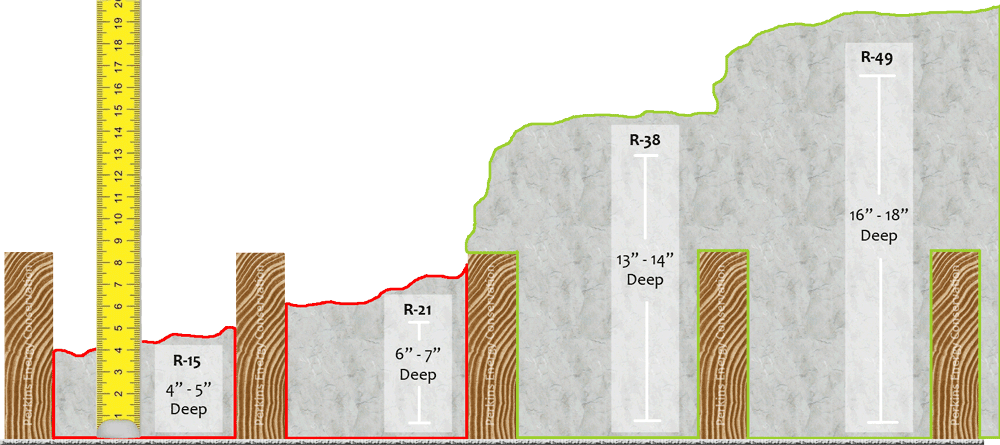Duct Blaster HVAC Leak Testing
A blower door is an innovative diagnostic tool used in energy audits to measure a building's airtightness. By simulating pressure differences, it helps detect and quantify air leaks, enabling precise identification and sealing of areas that compromise energy efficiency and indoor comfort.
Duct Leak Sealing
When combined with a blower door, an infrared scan is a powerful duo in energy auditing. The blower door pressurizes or depressurizes the building to reveal air leaks, while the infrared scan visually highlights temperature differences, making it easy to pinpoint energy-wasting gaps in the building envelope.
Learn MoreAdditional Pressure Pan Testing
During a blower door test, a pressure pan is positioned over supply and return vents to measure air pressure differentials, enabling the evaluation of heat or cooling loss and the identification of potential airflow issues or leaks within specific duct runs. *There is an additional cost to perform this test during a blower door.
Duct Blaster Testing
Ensuring the airtightness of your ducts through comprehensive leak testing and subsequent sealing is a crucial aspect of enhancing your home's energy efficiency, comfort, and air quality. Leaky ducts can result in substantial energy loss as conditioned air escapes, forcing your HVAC system to overwork and raising energy expenses. Thorough testing identifies leaky areas, allowing for proactive measures to seal them effectively. By sealing these leaks, you not only cut energy costs but also maintain consistent home comfort, ensuring even distribution of heating and cooling. Moreover, sealing duct leaks blocks the entry of dust, pollutants, and allergens into your HVAC system, significantly enhancing indoor air quality and fostering a healthier living environment. This investment in leak testing and sealing contributes to an efficient and superior ventilation system for your home.
It's worth noting that many HVAC contractors overseeing duct installation may overlook air leak testing on completed projects, and not all contractors consistently ensure proper duct sealing during installation or replacement, underlining the importance of post-installation testing and sealing procedures.
Duct Leak Testing
$250 / per unit
- Duct Blaster Pressure Test
- Duct Leak Inspection
- Duct Condition Inspection
- Report Of Duct Pressure Test
- Pictures Of Problem Areas
- Infrared Test
- Blower Door Testing
- Repairs Not Made
How A Duct Blaster Works
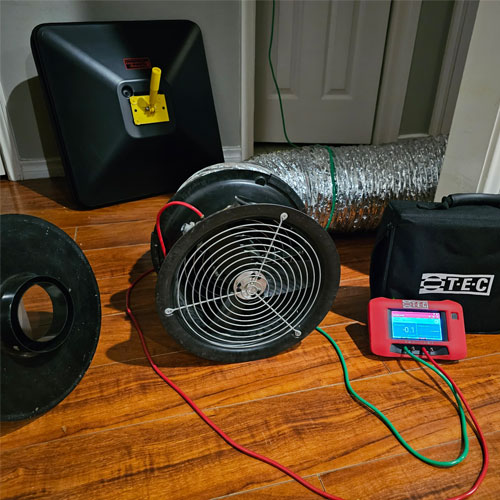
The Duct Blaster
The duct blaster is an integral tool in evaluating and enhancing a home's energy efficiency. This equipment is attached to the return air grill of your HVAC system, and all supply registers in the home are sealed off with a special duct sealant tape. The duct blaster system then measures the airtightness by pressurizing or depressurizing the home's duct system. By depressurizing the ducts, the duct blaster helps to simulate conditions that reveal leaks or weaknesses in the duct system and return air cavities. Any leaks or issues are then identified through precise measurements and pressure differentials. In addition to the duct blaster calculating the total cfm of duct leaks, the duct system can be pressurized to force air out of the leak locations to physically feel and locate the leaks. Once these problem areas are pinpointed, they can be sealed using duct sealing mastic or specialized tapes to seal off these leaks. Testing and sealing the leaks in the duct system significantly improves the overall performance of the HVAC system by ensuring that conditioned air reaches its intended destination without wasteful leakage. Additionally, it ensures that the air being pulled into the system does not come from areas like the hot or cold attic, thereby enhancing energy efficiency and reducing utility costs.
Why Test With A Duct Blaster:
- Energy Efficiency: Prevents wastage of conditioned air, reducing energy consumption and lowering utility bills.
- Cost Savings: Improved efficiency leads to significant long-term cost savings on heating and cooling expenses.
- Home Comfort: Ensures even heating and cooling distribution throughout your living spaces.
- Indoor Air Quality: Sealing prevents pollutants and allergens from entering your ducts and circulating in your home.
- Health Benefits: Enhances indoor air quality, benefiting respiratory health, especially for those with allergies or sensitivities.
- HVAC Longevity: Reduced strain on the HVAC system prolongs its lifespan and minimizes the need for repairs.
- Regulatory Compliance: Aligns with energy efficiency regulations in certain regions.
- Home Value: Enhances the resale value of your home by showcasing energy efficiency and comfort.
- Peace of Mind: Provides confidence that your HVAC system operates optimally and your home is efficient and healthy.
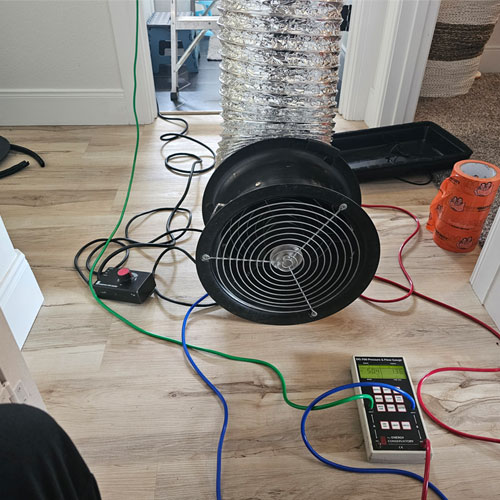
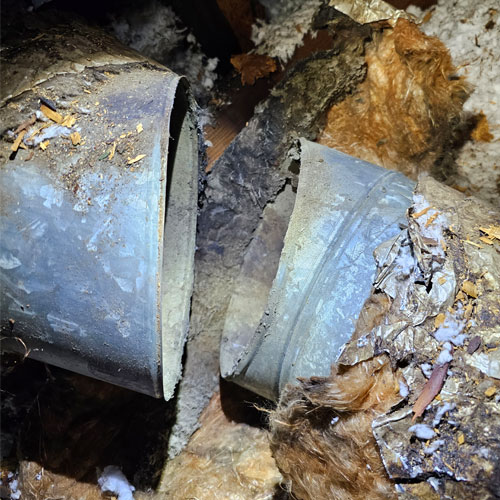
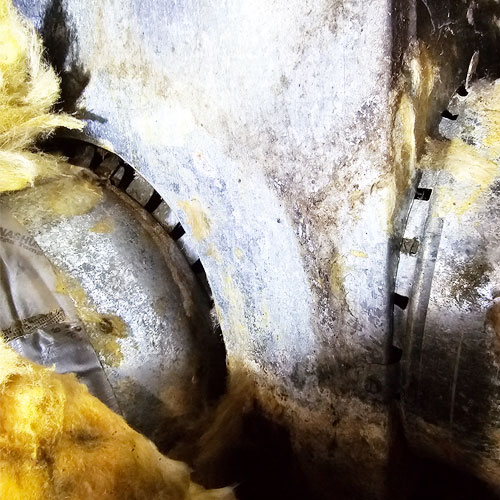
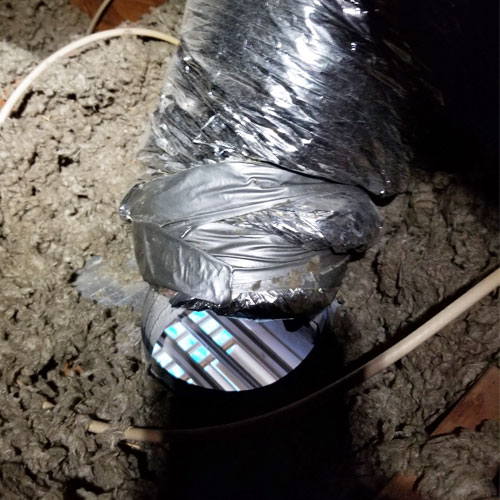
Duct Blaster: Just part of the puzzle
Blower Door Testing
$250
- Blower Door Pressure Test
- Infrared Scan
- Pictures Of Problem Areas
- Gas Leak Test If Applicable
- Report Of Air Tightness Testing
- Report Of Air Tightness Testing
- $50 Additioanl For Pressure Pan Test
- Duct Leak Testing Not Included
- Repairs Not Made
Complete Home Performance Test
$400
- Blower Door Pressure Test
- Duct Blaster Test
- Infrared Test
- Gas Leak Test If Applicable
- Pictures Of Problem Areas
- Report Of Air Tightness Testing
- Recommended Upgrades
- Repairs Not Made
Duct Leak Testing
$250 / per unit
- Duct Blaster Pressure Test
- Duct Leak Inspection
- Duct Condition Inspection
- Report Of Duct Pressure Test
- Pictures Of Problem Areas
- Infrared Test
- Blower Door Testing
- Repairs Not Made
Is Your Attic Costing You Money?!?!
All it takes is a quick peek to find out! Many older homes have more air leaks and less insulation than homes built today. If your attic floor is insulated but the wood beams (joists) are still visible, you probably don’t have enough attic insulation and it wouldn’t be a bad idea to reach out to us today for a free insulation quote!
